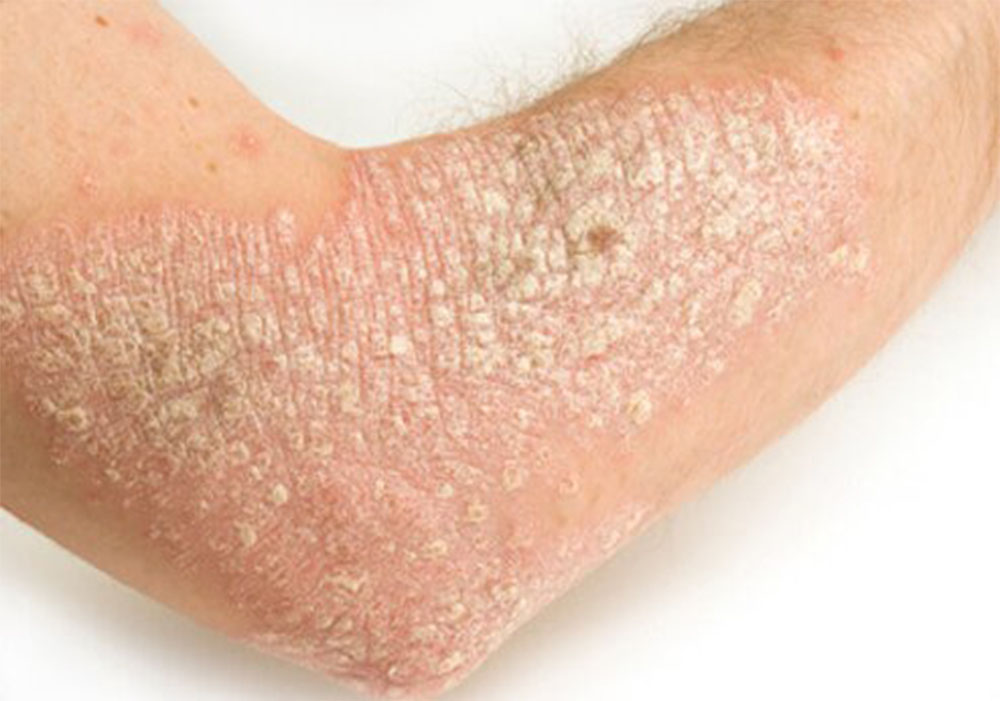Homeopathy for Psoriasis
Psoriasis is a hereditary, papulosquamous skin disorder can have multiple clinical presentations and varies widely among different individuals.It is typically a chronic and recurring disease that is best characterized by well-demarcated erythematous plaques with scaling. The plaques can be localized, which is the most common presentation, and are confined to only certain delineated areas of the body. Typically, plaques are seen most commonly on the elbows, knees, and scalp. There are other variants of psoriasis. In palmoplantar psoriasis, lesions are limited to the soles of the feet and palms of the hands. In contrast, generalized pustular psoriasis and generalized erythrodermic psoriasis can involve the entire body and be a life-threatening condition, even necessitating hospitalization, especially when seen in association with acute respiratory distress syndrome. Inverse psoriasis in intertriginous and tends to be on flexural areas of the skin.
Causes of Psoriasis
• Inherited from family
• Stress, depression
• Undue sweating
• Skin injuries like cuts, scrapes, chemical irritation, tattoos, burns, vaccination and shaving
• Food allergens
• A strep infection, upper respiratory viral infection, boils, thrush or HIV
• Certain medications like anti-malarial drugs, Corticosteroids, medications used to treat high blood pressure, arthritis, heart conditions and depression
• Sunburns
• Cold and dry weather
• Hormonal imbalance
• Smoking and heavy alcohol consumption
Symptoms of Psoriasis
• Patches of dry skin
• Itching and burning
• Discomfort and Insomnia due to itching
• Pain
• Cracked and bleeding skin
• Blisters with pus
• Fever in cases of Pustular Psoriasis
• Yellow or pitted nails
• Joint pains with swelling
• Low self esteem and embarrassment because of your looks
• Social isolation
• Suicidal thoughts
Types of Psoriasis
1. Plaque psoriasis
Most common form; also known as psoriasis vulgaris. It may occur anywhere on the body, including the genitals and soft tissues inside the mouth.
2. Nail psoriasis
About 50% of persons with active psoriasis have psoriatic changes in fingernails and/or toenails. Nail plate is deeply pitted; nail has a yellow to yellow-pink discoloration; white areas appear under the nail plate; nail plate crumbles in yellowish patches; and the nail may be entirely lost.
3. Scalp psoriasis
.
4. Guttate psoriasis
This cultivates in children and young adults following a throat (strepto) infection. It materializes as small dot sized red spots on the chest, arms and legs.
5. Inverse psoriasis
Mainly affecting the skin in the armpits, groin, under the breasts and around the genitals. More common in overweight people and is worsened by friction and sweating.
6. Pustular psoriasis
This appears as tender areas of fiery red skin with white pus filled blisters mainly on palms and soles. It can also cause fever, chills, severe itching, weight loss and fatigue.
7. Erythrodermic psoriasis
It can cover the entire body with a red, peeling rash that can itch or burn intensely. This can be life threatening because the skin loses its defensive function and may not be able to safeguard against heat and fluid loss nor preclude harmful bacteria from entering the body.
The first MYTHS: Psoriasis has no cure
FACT (Based on the thousands of case treated at our centres):
Psoriasis can be cured if treated early and when the condition is limited to a few patches. Even chronic, widespread lesions can be cured or put into remission. There is no need to lose hope as homeopathy has helped many of cases.
The second MYTHS: Psoriasis is contagious
FACT: You can be assured that you will not communicate this condition merely by touching someone. Though not contagious, your child may be predisposed (genetics) to this ailment. We do recommend that children be treated as soon as possible in order to have a complete chance or recovery and cure.
The third MYTHS: Corticosteroids are effective
FACT: Corticosteroids can be effective initially. However, they are not effective in the long term and may produce several adverse effects such as: skin atrophy, hypo-pigmentation, stretch marks and systemic absorption. Also, withdrawal of topical corticosteroids can lead to a rebound phenomenon with worsening of the condition.
The forth MYTHS: Natural skin creams are useful against psoriasis
FACT: External creams only help in lubricating the dry plaques and offer temporary relief. Majority of creams labeled as ‘natural’ or ‘herbal’ may contain coal tar derivatives, salicylic acid etc which are not herbal forms.
Why homoeopathy for psoriasis
Last but not the least, psoriasis is not an external but an internal disorder, arising out of faulty immune system with genetic predispositions. Needless to say that the disease is deep seated and calls for well planned deep acting homeopathic medicines. Allopathic treatment with steroids can suppress the symptoms of the disease but cannot cure the disease. On the other hand, it is homoeopathic treatment that has the potential to stimulate body’s natural healing capacity and to restore the disturbed immune system.
Homeopathy has gained a good reputation for curing psoriasis and other chronic skin diseases. No sticky external applications and no steroid are used. It cures naturally by increasing one’s immunity and hence can cure it permanently. Medicines are completely harmless and can be taken for longer durations very safely. After starting the homeopathic treatment, the itching, burning pain gets reduced, eruptions disappear gradually and the patient feels good in every way. Homeopathy targets the source of the problem with no damaging side effects.
Homeopathic treatment for psoriasis
Homeopathy is one of the most popular holistic systems of medicine. The selection of remedy is based upon the theory of individualization and symptoms similarity by using holistic approach. This is the only way through which a state of complete health can be regained by removing all the sign and symptoms from which the patient is suffering. The aim of homeopathy is not only to treat psoriasis but to address its underlying cause and individual susceptibility.

